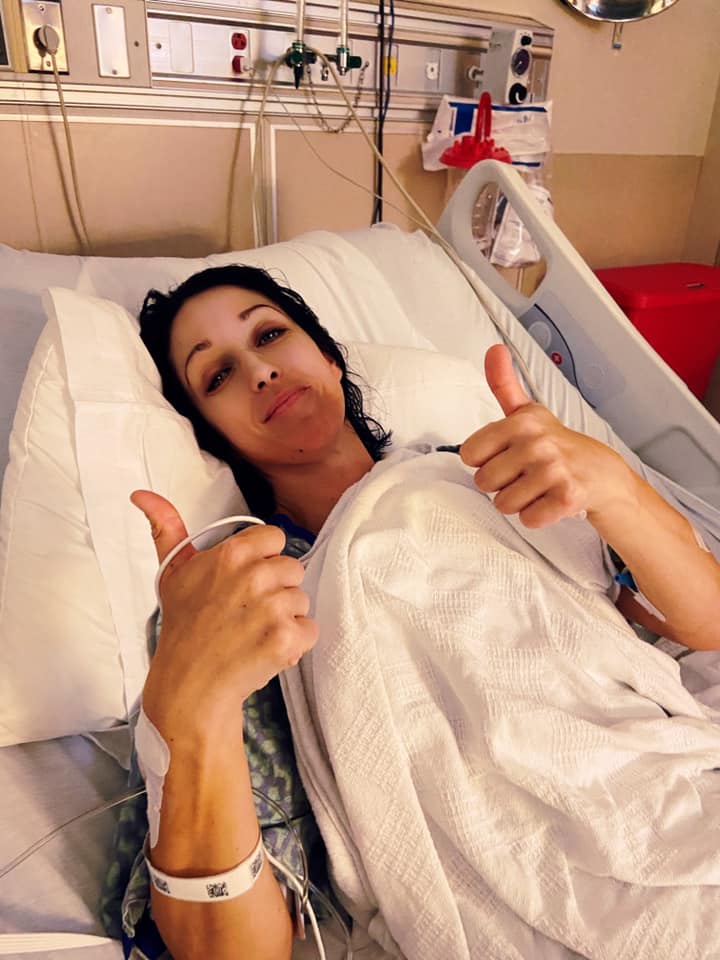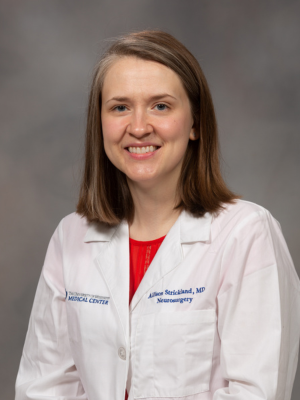
Innovative Treatment Leaves Little To No Deficits
Published on Wednesday, December 21, 2022
By: Rachel Browning Truong, rbrowning2@umc.edu
One week after her fortieth birthday, Maggie Slusarczyk, a Polish woman living in Madison, Mississippi, found herself lying on her front lawn unable to speak or move. That morning she woke up with a terrible headache, but got her two boys off to school and sent her husband on his way. She began getting ready for work when suddenly she heard a popping noise in her head and could feel warm pressure spilling over. She called her husband and said, “something is happening to me. I don’t think I’m going to make it. I think I’m dying.” He immediately turned around to drive home. She called 911 and started telling them her symptoms, but her speech became garbled. She stumbled outside for fresh air and then collapsed in her front yard. Though she faded in and out of consciousness, she remembers the paramedics and her husband arriving at the same time. They loaded her in the ambulance as she tried to scream that her head was killing her. She was taken to the University of Mississippi Medical Center for a stroke.
The popping noise Slusarczyk heard was an aneurysm rupturing in her brain. An aneurysm is a ballooning or weakening area of an artery. Slowly growing, the affected area becomes weaker as it enlarges until the point of rupture. When an aneurysm ruptures, it bleeds into surrounding brain tissue, resulting in a hemorrhagic stroke. Slusarczyk experienced all the symptoms of a hemorrhagic stroke: the worst headache of her life, trouble speaking, drooping eyes, stiff neck, and the list goes on and on.
When she arrived at the hospital, the UMMC stroke team immediately stabilized her. Treating stroke victims as quickly as possible can be the difference in life or death. UMMC’s award-winning stroke center provided Slusarczyk with just the type of fast reaction she needed.
Once stabilized in the ER, she had several types of CT scans to get initial imaging of her head. These scans verified that she had a subarachnoid hemorrhage or bleeding on the surface of her brain. Locating the source of bleeding proved to be a much harder task. One scan showed the possibility of an aneurysm located near the base of her brain on the right superior cerebellar artery.
A specialized neurosurgical procedure called a diagnostic angiogram was required. A diagnostic angiogram is a minimally invasive imaging procedure that provides a roadmap of the brain using a catheter to spread dye through the brain’s blood vessels. Slusarczyk’s angiogram revealed a “dissecting right superior cerebellar aneurysm” – an uncommon combination of location and type of aneurysm. It was on a vital artery and the vessel wall initially ripped rather than ballooned out. If left untreated, it would grow bigger and rupture again.
“Given her specific case, the typical treatment would be to trap the aneurysm and perform a bypass or to sacrifice the artery by clipping or coiling. Risk of stroke and permanent deficit would be high,” said Dr. Allison Strickland, a neurosurgeon subspecialized in vascular surgery at the University of Mississippi Medical Center. “That wasn’t acceptable to me. Maggie was a runner, she was healthy, she was an active person. She had a family with young children. I wanted to preserve as much function for her as possible.”
Dr. Strickland devised an alternative endovascular option that might spare Slusarczyk’s function. The arterial wall had to heal so that blood could flow normally again. Unfortunately, the artery was too small for the typical technology to fit properly.
A stent is a tiny, woven wire tube that is usually used to support arterial walls when coiling a saccular aneurysm, eventually becoming part of the wall itself. Slusarczyk’s aneurysm wasn’t saccular, so there was nothing to coil off. Strickland wanted to use the stent to help stabilize the arterial wall.

“Dr. Strickland is just the best. She’s so smart and kind. She explained everything to me; my options and the risks for each. I completely trusted her opinion and was ready to fight to live through all of this,” said Slusarczyk. “I wasn’t ready to die just yet and I thank God for Dr. Strickland being my doctor!” They moved forward with the stent.
In the days after her stroke, Slusarczyk developed vasospasms, adding even more complexity to her case. Vasospasm can be one of the body’s natural reactions to a subarachnoid hemorrhage. The blood from the rupture irritates the surrounding artery, causing it to narrow, blocking blood flow. The placement of the stent helped her get through this acute period without major growth in the aneurysm site.
“The first week in the hospital was mostly a blur, but that second week I felt so much better!” Slusarczyk remembered. “After getting the stent they needed to observe me, so I was there just hanging out and talking to the nurses and staff. They became my family. I remember feeling much better and thanking Dr. Strickland for saving my life. She said, ‘Don’t thank me yet. We still aren’t out of the woods.’’’
Dr. Strickland knew the stent wouldn’t be enough to keep Slusarczyk’s aneurysm from growing back, but it would buy some time for her body and brain to recover from all her complications. Ultimately, she needed a “flow diverter” which meant another endovascular surgery.
Much like a stent, a flow diverter is a flexible woven tube used to rebuild the structural integrity of a vessel wall. With a tighter weave, the flow diverter would help heal the arterial wall and block any blood that might make the aneurysm grow. Once Slusarczyk’s overall condition had improved, Strickland could safely place the flow diverter. It worked, but she still had a long road to recovery.
Slusarczyk developed hydrocephalus, a common condition after a subarachnoid hemorrhage. Cerebral spinal fluid builds up in the cavities within the brain, putting pressure on the brain. The treatment meant another surgery. Strickland placed a device to drain the excess fluid called a shunt.
“Do you see all these gray hairs? Maggie gave them to me,” said Dr. Strickland. “She says I saved her life multiple times, but we got through it together. She had a very difficult journey and is an extremely tough individual.”
“I think having a sense of humor really helped me in my recovery,” Slusarczyk said. “It seemed like anything that could go wrong for me, did go wrong, but I know I’m very fortunate to even be alive. Staying positive goes such a long way.”
Slusarczyk can walk, talk, exercise, and live her normal life. She has little to no deficits thanks to Dr. Strickland’s innovative approach to her treatment.
“We worry about so many things in our life, wanting a better car, better house, better vacation,” said Slusarczyk. “I remember laying on the ground thinking I was going to die and just wanting to see my kids again. I truly didn’t think I was going to make it. But I made it thanks to Dr. Strickland. She saved my life so many times. I’ll never take it for granted again.”


